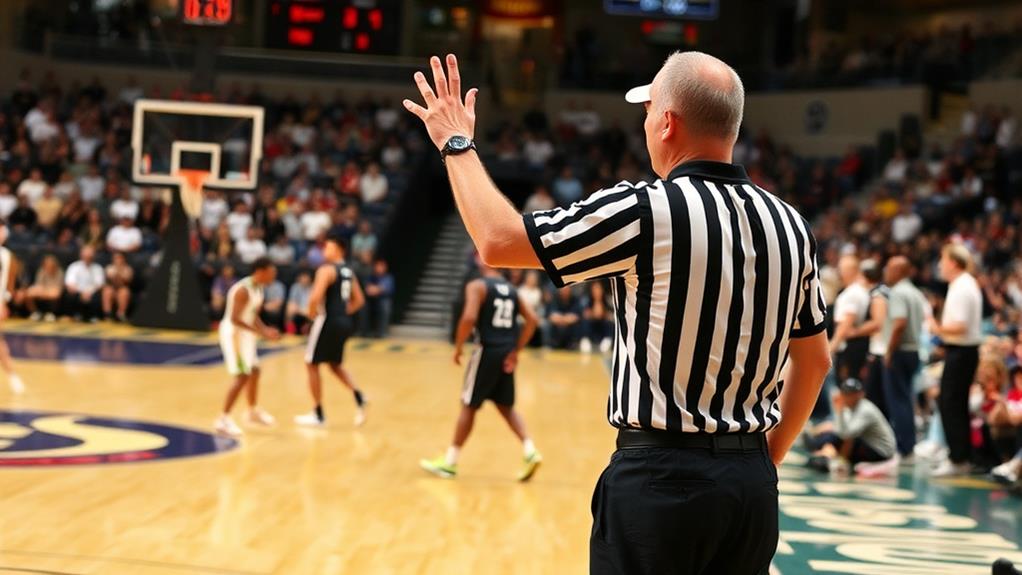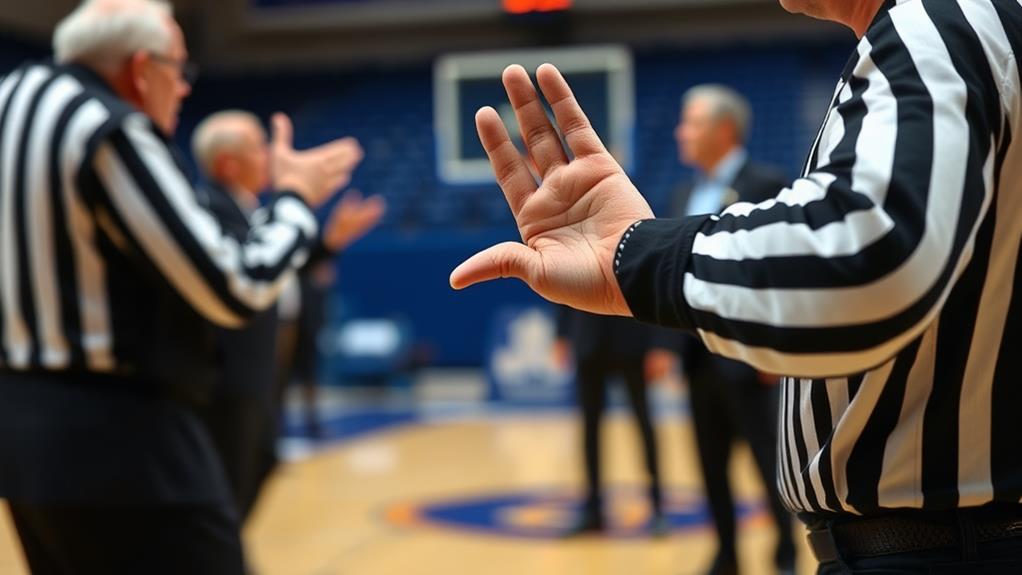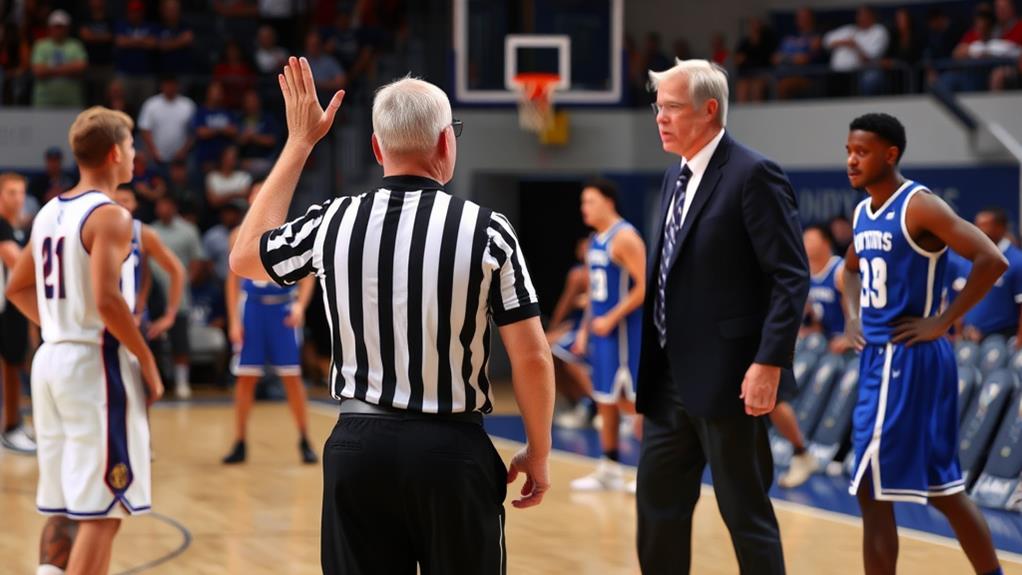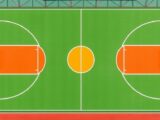
Decoding Basketball Hand Signals: What Referees and Coaches Are Saying
October 9, 2024Decoding basketball hand signals is key to understanding what referees and coaches communicate on the court. For instance, a referee signals a traveling violation with a circular arm motion, while a double dribble is indicated by moving hands up and down. Foul signals are equally important; a raised hand means a foul occurred. Then there's clock management—the signals for starting and stopping the clock help keep the game flowing smoothly. Each gesture reflects the game's rhythm and rules. By paying attention to these signals, you can enhance your appreciation of basketball's intricate dynamics and learn more about the game.
Understanding Violation Signals
Understanding violation signals is essential for players and fans alike, as it helps you grasp the flow of the game. Referees use specific hand signals to communicate various violations, and recognizing these can enhance your understanding of basketball. For instance, when a player commits a traveling violation, the referee places their arms in front of their face and makes a circular motion. This signals that the player has moved without dribbling, which is a fundamental rule in maintaining fair play.
Just as in soccer, where player conduct and team composition are vital for the game's integrity, understanding basketball violations promotes fair competition and sportsmanship field dimensions and equipment requirements.
Another important signal is for a double dribble violation. In this case, the referee holds their hands in front, palms down, and alternately moves them up and down, indicating that a player has dribbled again after stopping.
Additionally, pay attention to the 3-second violation signal; the referee points three fingers down and swipes their hand back and forth. This means an offensive player has lingered in the key too long, disrupting the game flow.
Recognizing Foul Signals
Recognizing foul signals is just as important as understanding violation signals, as they play a significant role in the game's dynamics. When a referee blows the whistle and raises a closed hand, it immediately indicates that a foul has occurred.
Knowing the distinct hand signals for different fouls can help you anticipate the flow of the game and prepare for potential free throws. This awareness is particularly vital as defensive strategies evolve, especially with the increasing emphasis on perimeter defense and analytics that influence how fouls impact game play historical shifts in defensive approaches.
Here are three common foul signals you should watch for:
- Blocking Foul: The referee places both hands on their hips, clearly showing that a player has impeded an opponent's path.
- Charging Foul: A fist is made with one hand and punched into the open palm of the other, signaling that an offensive player has collided with a defender.
- Hand-Checking Foul: The referee chops one hand across the opposite wrist, indicating that a player has made illegal contact while trying to defend.
Clock Management Signals

Clock management signals are essential for maintaining the flow of the game and ensuring everyone is on the same page. When a referee needs to halt play, they'll use the "stop the clock" signal, typically indicating a foul or violation. This is particularly significant in high-pressure situations where efficient ball movement and quick decision-making are indispensable to optimize scoring opportunities.
You'll see this signal often, as it helps players and coaches quickly understand the situation.
Once the reason for stopping play is resolved, the referee will raise their hand to signal "start the clock," letting everyone know it's time to resume.
If you're keeping an eye on the shot clock, watch for the "visible count" signal, which shows how much time is left for the team to take a shot. This helps you gauge their urgency on the court.
Player and Scoring Signals
When the game resumes after a stoppage, player and scoring signals come into play to guarantee everyone knows what's happening on the court. Referees use specific hand signals to communicate key events, ensuring clarity for players, coaches, and fans alike.
These signals have evolved alongside the game, reflecting innovations in gameplay and regulations over the years, such as the introduction of the evolution of equipment and player gear.
Here are three essential signals you should recognize:
- Free Throw: When a player successfully makes a free throw, the referee raises one hand with an open palm, indicating one point scored.
- Three-Point Field Goal Attempt: If a player attempts a three-point shot, the referee extends one arm sideways at shoulder height, signaling the potential for three points.
- Successful Three-Point Field Goal: After a successful three-point shot, the referee raises both hands above their head with fingers extended, clearly emphasizing the three points awarded.
Additionally, during a jump ball situation, referees signal by raising both hands above their heads, ensuring everyone knows the ball is up for grabs.
Substitution and Timeout Signals

Understanding substitution and timeout signals is vital for following the flow of a basketball game. When a referee performs the substitution beckoning signal, they extend one arm directly out to the side. This action invites players to enter or exit the court, guaranteeing the game continues smoothly.
It's essential to pay attention to these gestures, as they help maintain the rhythm of play and promote inclusivity and equality in the sport.
For a charge timeout, the referee raises one arm overhead with an open hand. This gesture indicates that the team has called for a timeout, allowing coaches to regroup and strategize.
Additionally, the media timeout involves both arms raised above the head, signaling breaks specifically for media purposes.
To communicate the timeout duration, referees use specific gestures to signify how long the timeout will last. This clarity helps players and coaches prepare for the upcoming play.
Remember, the substitution protocol guarantees that players can only enter or exit at designated times, and the referee crosses their arms to indicate a player exchange.
Being attuned to these signals will enhance your understanding of the game and its dynamics.
Conclusion
Now that you've cracked the code of basketball hand signals, you're practically a referee whisperer! You'll spot violations and fouls like a hawk, and you'll manage the game clock as if you're controlling a high-stakes thriller. With your newfound knowledge, you'll decode substitutions and timeouts faster than a speeding bullet! So, grab your whistle, strut your stuff, and watch as everyone marvels at your basketball savvy. You're not just a fan; you're a basketball signal-seeing superhero!


